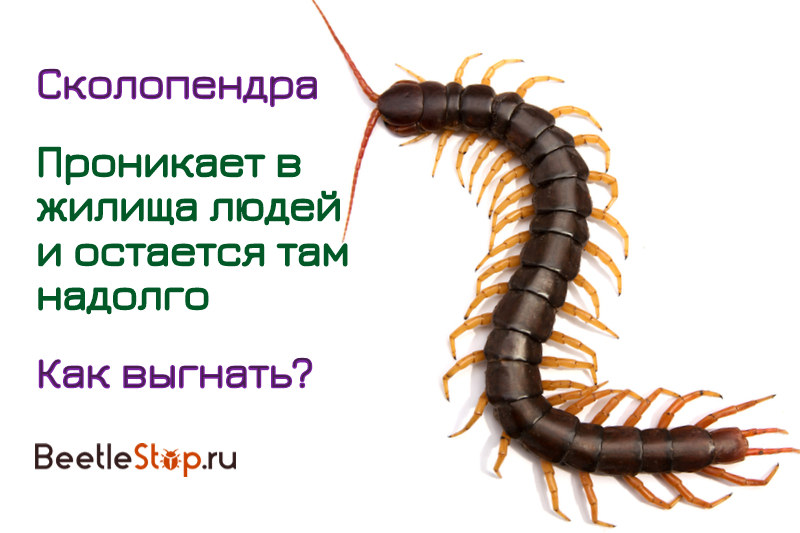How to deal with scolopendra: recommendations of professionals
Neighborhood with scolopendra can hardly be called pleasant. When this creature starts up in the house, many simply panic. Against his background, even cockroaches look much prettier. And even though these centipedes with a long body mostly live in moist forests, sometimes they nevertheless climb into residential buildings and stay there for a long time. And here it is necessary to clearly know how to deal with scolopendra, since far from any method used to destroy the domestic insects we are used to is capable of approaching.

Scolopendra in the house
With its appearance, the scolopendra resembles a large worm with many well-developed moving legs. The color of her body can be different: from light to dark brown. Dimensions are about 12-15 cm.
On a note! Such a millipede as a scolopendra lives mainly in warm regions, and where individuals with a body length of up to 30 cm are found especially hot!
Acceptable Living Conditions
Scolopendras prefer high humidity and warm rooms. At the same time, they usually go unnoticed during the day, hiding in secluded places, and at night they leave their cozy shelters and go in search of food.
Often, scolopendras are equipped in bathrooms and toilets, and often settle in kitchens under the sink, as well as in wet cellars and basements. Sometimes they can be found in the attic. In most cases, these creatures run into private houses, but there are situations when they find themselves even in apartments - as a rule, these are the first floors.
Methods of struggle
Having discovered a scolopendra, you should not think that she ran by accident and alone. If a millipede has chosen your home, then most likely she has not settled here alone.
Recommendation! When a scolopendra appears in the house, it is advisable to observe maximum caution. Before going to bed, always check the bed and do not go barefoot!
In order to get rid of scolopendra in the house, first of all, it is necessary to establish exactly where they are hiding, and remember that shelter can be in one of the rooms or in the basement. When a nest is detected, one should act very carefully and in no case try to grab millipedes with your hands. To do the following:
- ventilate the infected room and dry wet and damp corners;
- if there is stagnant water somewhere, then it should be wiped and the source of leakage corrected;
- to fight against domestic insects - such include cockroaches, ants, fleas, etc., because they are the main source of food for scolopendra.
Do not make mistakes!
Quite a few, when a scolopendra is discovered, try to get rid of it in ways that in practice do not bring any results, and sometimes can even do harm. These include:
- Attempts to “nail” a millipede with improvised means - neither a newspaper nor slippers are able to kill a scolopendra. This is due to the fact that her body is covered with a very dense shell, which reliably protects adults from such attacks. In addition, it is quite nimble and moves quickly, so most likely it will not work to make a targeted hit.
- The use of aerosols against crawling insects.Since this millipede is not an insect, it is simply useless to use the above means against it. At the same time, it has a much larger size than insects, and therefore the concentration of toxic substances should be quite high, which such drugs can not provide. In addition, scolopendras run very fast, and therefore it is almost impossible to complete a long spraying.
- Using sticky traps. Here, again, the impressive size of millipedes will interfere. Plus, even if an individual sticks and loses several legs in an attempt to get out, it will run away without much difficulty, and the limbs will soon grow back.
- Attempts to catch her with his hands, a jar, a bag, etc. This is absolutely impossible, since in danger the numerous walking limbs of this creature become poisonous.
How to prevent scolopendra in your home
In order to prevent the occurrence of scolopendra, it is necessary:
- Keep all rooms clean and dry. To do this, they must be regularly ventilated and combat dampness. Check the integrity of the waste pipes and if a violation of their integrity is detected, immediately correct the situation. Remember that neither in the kitchen, nor in the bathroom, nor in the bathroom should there be stagnation of water.
- Make sure that the house is inaccessible to scolopendra. To do this, all cracks and cracks in the floors and walls must be repaired, as well as to eliminate the gaps that often appear around the window frames and the front door. In addition, we should not forget that these millipedes can settle even under the floor if it is constantly wet. This happens especially often when there is a cellar under the house. In such cases, the coating must be removed and dried.
- Sometimes scolopendras enter houses through open windows. To prevent intrusion, mosquito nets should be installed on them. In addition, it is desirable that the ventilation openings be covered with fine mesh grills.
And of course, attention should be paid to cleanliness in the area adjacent to the house. Since these millipedes first settle in the yard, all the garbage must be taken out, the fallen leaves removed and construction materials and firewood hidden.


 (votes: 10, average rating: 4,80 out of 5)
(votes: 10, average rating: 4,80 out of 5)
I use boiling water, I kill with a stick if under the ceiling, I crush with my foot. Crawl into bed, even bit. A bite equals 20 bees.